You’ve just come home from work, you’re tired and hungry, and would like to eat in 20 minutes. How do you make a meal that’s easy and quick, but new and different?
The solution is to fry a meat and boil a starch, but use a tasty sauce to give variety to this most easily-cooked meal. One of our favorite sauces is something we call Pacific Sweet&Sour Sauce.
The Sauce
The essential ingredients are rice syrup for sweetness, lemon juice or rice vinegar for sourness, tarragon, rosemary, and garlic. An optional ingredient is any kind of chili powder for spiciness; we used the Vietnamese spicy sauce at top – this one happens to be Huy Fong Chili-Garlic Sauce and is made from chili, salt, garlic, and distilled vinegar.
Of course you can substitute: basil works well as a herb, and coconut milk is an excellent addition to the sauce. Fish sauce gives it a more Vietnamese flavor.
Dice the herbs and set them aside; mince the garlic and mix with the sweet, sour, and spicy ingredients:
The sauce is ready. We used about 1 tbsp rice syrup and juice of a full lemon.
Pacific Sweet&Sour Salmon
Removing the central bone from the salmon steaks speeds up cooking significantly, and finishes the meat when the skin is cooked to just the right crispiness. Here we’ve filleted, and put salt and pepper on, two salmon steaks:
We put a bit of coconut oil in the pan and cooked at medium-high heat.
When the color has changed about 2/3 of the way up the sides of the steaks, which may take 3-4 minutes, they’re ready to flip. After flipping cook another 2 minutes and add the sauce:
With the sauce in cook another 1 minute on one side, and flip again to finish for another minute. Add the herbs in this final minute:
Be sure to keep all the sauce when you transfer to a serving plate:
Pacific Sweet&Sour Pork Bellies
We like pork belly a lot: it is a tasty, fatty cut of pork, and we like the natural flavor better than processed bacon.
If you’re nervous about timing, you don’t have to cook everything together: you can pre-cook the meat, then add it back to the sauce.
Here’s an example. After cooking pork belly slices, remove the meat and add the Pacific Sweet&Sour sauce to the pan oil:
After a minute of heating and stirring, add the herbs:
Return the meat to the pan, mix, and serve:
Pacific Sweet&Sour Beef Liver
We find this sauce works very well with beef liver too:
Shou-Ching, who doesn’t like the taste of beef liver, is happy to eat this.
If you really dislike the taste of liver, you can further remove the liver taste by boiling the beef liver slices briefly before putting them in the pan.
Conclusion
This sort of meal is easily cooked in 20 minutes or so. Alongside the meat, we prepare a starch – usually rice cooked in our rice cooker or warmed in the microwave (one batch lasts us 2-3 days), or potatoes or taro boiled or re-heated in the microwave (again, we prepare enough for 2-3 days) – and serve assorted vegetables – for us, usually various flavors of kimchi and seasoned seaweed. Kimchi and seaweed require no cooking.
We’re having Pacific Sweet&Sour Mussels tonight, with coconut milk in the sauce. Create your own variations! They’ll all taste great.







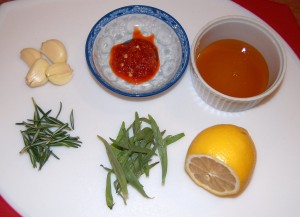
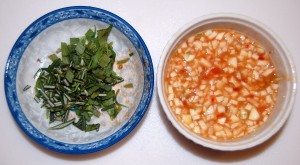
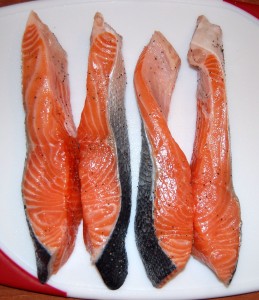
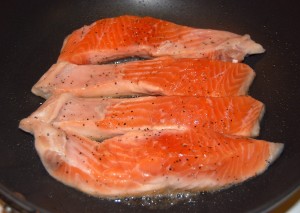
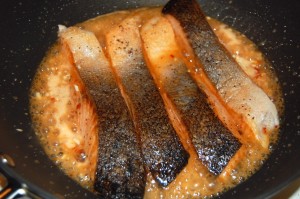
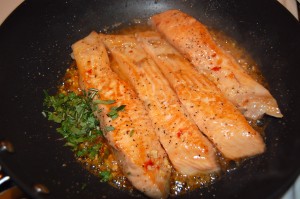
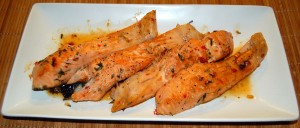
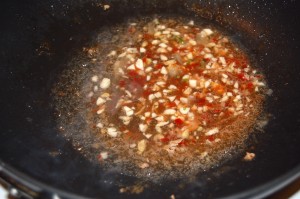
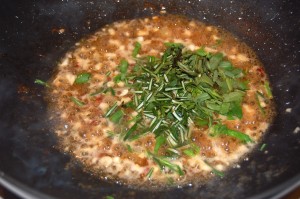
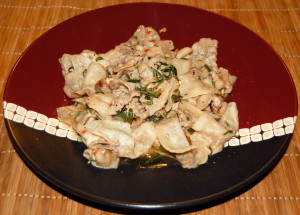





This recipe sounds good too.
We had our weekly salmon following an earlier recipe by putting everything including sliced veggies in a baking dish, poured melted butter over everything and cooked it in a med. oven for about 20 minutes. Prepared rice with beef broth and butter in the meantime. Everything was ready at the same time, was delicious and easy to clean up.
One of these days I really need to go to the Asian grocery store with you and Shou-Ching to pick out all the most amazing stuff.
looks delicious! we are going to enjoy that here 🙂
i have a question about “raw” fish and meat… i love eating my salmon as sashimi or only cooking the outside. i also prefer rare steaks – and to think i used to be a vegan ;). how safe is this? i would think it was better for vitamin and mineral content, but I am curious what your opinion is. would our ancestors have eaten it raw?
Hi erp,
The baked salmon is my recipe. This one is Shou-Ching’s.
Hi Emily,
It would be fun! We often go on Saturday evening, when it is less busy, but we can go another time if that is convenient for you. Let us know if you’d like to meet up. Kids would enjoy it too.
Hi claire,
I am not an expert on raw fish safety. I used to have sashimi often, but after hearing more of parasite dangers, I eat it much less often now.
Rare steaks should be safe. Just brown the surface. Ground beef needs to be thoroughly cooked however.
Our ancestors probably ate most things cooked from about 250,000 years ago, and many things cooked from as early as 1.8 million years ago. Hearths have been found dating back 450,000 years or longer, but they seem to have been used irregularly — maybe for feasts?
How is your gastroparesis? I see on your blog you improved through February, is it still better?
Best, Paul
Do you eat wild salmon? Unfortunately in Australia the only fresh salmon is farmed so I don’t bother with it. I do buy canned wild Alaskan salmon but then you have the problem with BPA in canned goods…..
Luckily I have found a local supplier of top quality kimchi. I’ve been eating her cabbage and bok choy kimchis every day for several weeks now. It’s so handy having something like that on hand so you don’t have to bother preparing vegies. Her dried squid and Korean style short ribs are quite nice too, although a little sweet for my low-carb trained taste buds. I’ve just borrowed six different Korean cookbooks from the local libraries so I can start making my own authentic meals!
Sweet! I am totally taking y’all up on that. Will email…and I’m typically free on Saturday nights 🙂
Hi GeeBee,
We eat both wild and farmed … We seem to be more willing than most other Paleo-ers to trust animals’ in-built detoxification systems. The toxins are getting detoxified once in the animal liver, then whatever is left over can probably be handled by our liver.
Koreans like to put sugar on their meats, that is a secret of Korean barbecue!
Kimchi is extremely convenient as well as tasty and healthy. Not all of them are spicy. I especially like white radish, and seaweed.
Have fun with the cookbooks! It’s an adventure.
Emily – Great! We’ll look forward to it.
Hi Paul,
I guess I won’t shy away from rare or cooked meat then 😉
Thank you for the inquiry about my health 🙂 The gastroparesis hasn’t been going so well lately. I got the flu while taking the nystatin and I haven’t really recovered since. I am taking symbion (the non-yeast containing version of threelac) and other probiotics to help heal. I am not quite sure what went wrong, but I think maybe I am eating too much fruit or carbs/sugar.
It seems like the best meals for my stomach are salad with meat/poultry/fish with lettuce or cooked veggies in coconut milk. But I find the food really heavy and after a week or two my intestines get sluggish and I start to crave fiber and carbs, but both are hard for my stomach (I did read your post about this and am incorporating the advice). Also, I get worried about not eating enough fruit and vegetables – if I eat a piece of meat I am just full and don’t want anything else for hours.
Tonight I thought of a new quick dessert to help with cravings that should probably go well: avocado blended with lemon juice and rice syrup. So I’ll see if that helps me through this difficult phase.
I also like eating fruit – but do you think its better for me to avoid it? Or should I just avoid fruits high in fructose?
Thank you so much for all your advice and the very informative blog! Slowly but surely I am getting my family to move to a healthier diet 🙂
All the best, Claire
Hi Claire,
So sorry about the backward step. Hopefully it’s 2 steps forward for each one back, and the next 2 will come soon.
If you believe you have fungal infections, you might try vinegar in place of lemon juice. Lemon juice is alkalinizing while vinegar is acidifying, and Candida seems to like alkaline. Lemon juice is good against bacteria or viruses.
Classic Italian dressings, with vinegar, oil, and herbs, are great against Candida.
I think fruit is OK in moderation, but I would tend toward low-fructose fruit like bananas and plums, or better yet to berries. Berries are good anti-fungal foods because the anti-fungal toxins are in the skin and they have a high surface area to volume ratio. I ate a lot of cranberries as an antifungal food when they were in season: http://perfecthealthdiet.com/?p=1296
I think the avocado and rice syrup and acid dessert is a good idea, if you tolerate that well it would be a good food.
Best, Paul
Thank you 🙂 I’ll give this a try and hopefully soon 2 steps forward 🙂 Best, Claire
Would the recipe work the same way with salmon filets instead of salmon steaks? Looks great!
Hi straw,
Yes! Salmon fillets are fine.
Sounds delicious!
Wow, looks good. Think we’ll have that tonight.
BTW, for those that don’t have a rice cooker, the rice recipe I posted from a Japanese chef on Emeril’s old TV program works really well for perfect rice.
Apologies for the tortured syntax 😉
Hi Paul,
I see you make rice for 2 or 3 days. Do you keep it in the fridge? I heard that rice that is not cooled down quickly after cooking and then is kept for 2 days might go mouldy because of the big surface exposed to moisture and air. It might sound silly, but sometimes I even heat it in boiling water to avoid that. Do you think my fear is unfounded? On a similar note, the potatoes are boiled in their skin and then kept in the fridge or outside? Fresh cooked potatoes are the best, aren’t they, after a day or two their texture changes.
Thank you for sharing.
Hi simona,
We let the rice reach room temperature before putting it in the refrigerator. We cover it and if condensation appears on the lid we drain it. We usually don’t smell any yeast until 7+ days. Boiling should be unnecessary – just heat it in the microwave.
Potatoes we keep in the refrigerator. Sometimes we peel them before boiling. Yes, fresh is best, it’s a matter of accommodating your work schedule.
Best, Paul
How long do you boil the liver?
Hi Frosty,
You can see when it changes color and becomes firmer – also it floats when fully cooked. Don’t overcook. Typically we add slices to the boiling water and remove after 3 minutes.
This sounds delicious! I find salmon to be one of the most delicious and rewarding foods out there. From the excellent protein and fat content to the fantastic taste, there is really no missing out! My wife tells me I have hyposensitive taste buds because I have a tendency to drench my salmon in lime 😀 it’s yummy though!
Hi Paul,
I noticed that you mentioned to Claire that lemons are alkalizing and thus feed Candida. Would that be true for tomatoes as well?
For years i have reacted in a delayed fashion to both of them…a slice or two of fresh tomato not so much, but cooked and reduced, big time. This has always puzzled me as it was not the stomach upset from these that some ascribe to too much acid. But instead waking in the night and staying wide awake for hours and then hung over and foggy brained for the following several days.
Ellen
Hi Ellen,
I’m not sure what component of the tomato may have caused that.
Tomatoes aren’t a citrus fruit so wouldn’t have the same effect as lemons.
Loren Cordain has worried over tomato lectin causing problems, but there’s not much data on that.
Tomatoes have fiber/pectin but feeding gut bacteria doesn’t seem a likely cause.
The symptoms sound like an intolerance to some tomato protein. Maybe cooking folds the protein and makes you more intolerant to it.
This is interesting: lycopene has antifungal activity: http://www.ncbi.nlm.nih.gov/pubmed/18092463. Maybe a tomato meal creates an influx of Candida cell wall components and that’s what excites the immune response.
Tomatoes can cause allergies, although this is not common.
Thanks Paul.
Well, even if I never know the exact mechanism at play, it will be interesting to see if reducing my fungal load enables me to eat tomatoes and lemons without reactions.
It will be a while before I do any experimenting. But I can’t tell you how encouraging it is to think that it might be worth trying.
And all thanks to you!!!
Ellen
Hi Paul,
Do you guys keep the skin on your salmon and eat it? I’ve read that salmon skin can have mercury and PCBs and is best to be avoided. But at the same time, I’ve heard the skin has lots of beneficial omega-3 fats, and I’d love to get more of these. I typically eat 2 pounds of salmon per week, unsure of whether to go forward with or without the skin.
Let me know what you think.
Thanks,
Jordan
Hi Jordan,
We often but not always eat the skin. We also eat the sauce it’s cooked in so we would pick up skin toxins, if they’re present, that way too.
Salmon are generally low in mercury because they’re low on the food chain. However, I’m open to evidence that the skin collects toxins. PCB is an environmental toxin and I would expect its levels to be highly variable from fish farm to fish farm. Hopefully at safe levels everywhere, but I haven’t looked into it.
Hi
I am curious on your take on the rice cooker and pressure cooker for cooking starches, I noted in your book that vigorous high temp cooking is inferior to more moderate methods like boiling. Do you feel that the rice cooker is not overly high temp? Also, regarding the cooking of potatoes you noted that high temp roasting is not as beneficial as boiling. If potatoes are par boiled and then finished in an oven does this also effect the integrity of the final product?
Thanks!
Hi Emily,
Pressure cookers are great. The temperatures are not high enough to generate toxins.
Any method of cooking that dries out potatoes is problematic.
Hello Paul,
Depite being a large male (6ft4inches, 14.5 stone age 34) by actual RMR is only 1300 calories! according to a machine that measured my Co2.
SO my question is… should I be eating less than 1300 calories of PHD foods to lose fat?
(I find that idea unbearable – but need to lose fat)
Also, I eat PHD but cannot kick sweet cravings for things like xylitol sweetened chocolote or dried fruit each day.
Thanks!
Nick